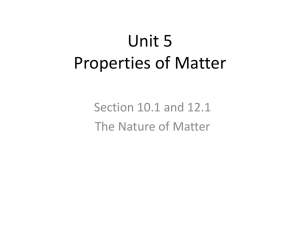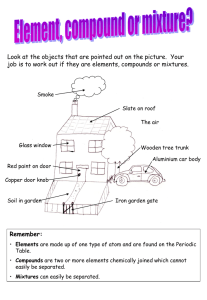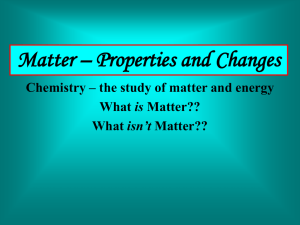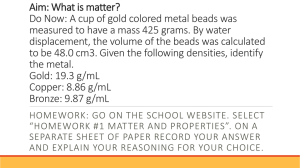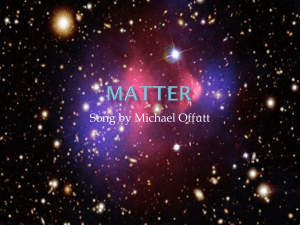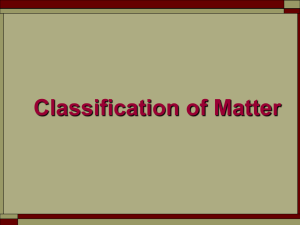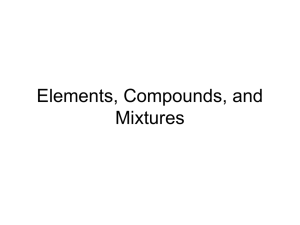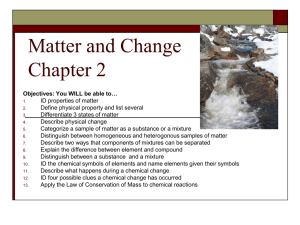File
advertisement
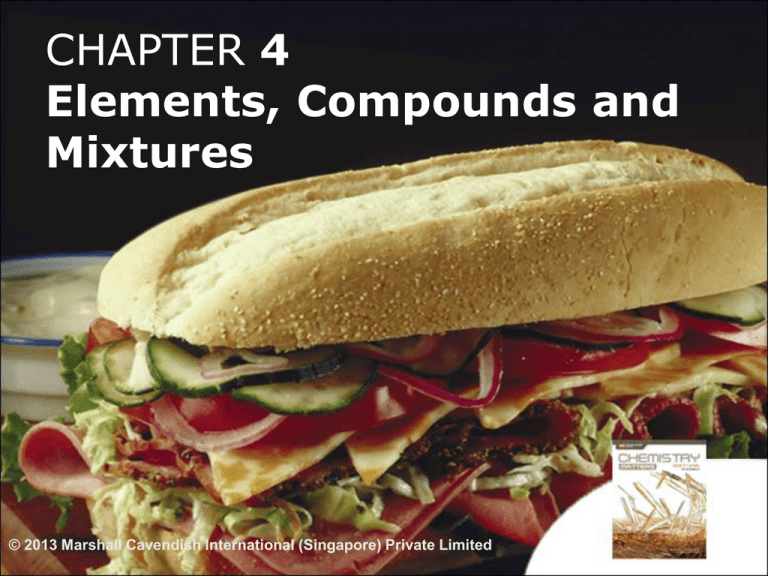
CHAPTER 4 Elements, Compounds and Mixtures © 2013 Marshall Cavendish International (Singapore) Private Limited Chapter 4 Elements, Compounds and Mixtures 4.1 Elements 4.2 Compounds 4.3 Mixtures 2 4.1 Elements Learning Outcomes At the end of this section, you should be able to: • define an element; • state the chemical symbols for a number of elements. 3 4.1 Elements What is an Element? It is a pure substance that cannot be broken down into two or more simpler substances by chemical processes. Examples: Carbon, copper, oxygen Sugar is not an element. When heated, it breaks down into carbon and water vapour. 4 4.1 Elements Is Water an Element? Water is not an element. It can be broken down into hydrogen and oxygen. Hydrogen and oxygen are elements. URL 5 4.1 Elements Chemical Symbols of Elements • Chemists use chemical symbols to represent elements. • Each symbol is unique, consisting of one or two letters. Element Symbol Element Symbol calcium Ca mercury Hg carbon C neon Ne hydrogen H silicon Si iron Fe sodium Na The names and symbols of all known elements are found in Periodic Table. 6 4.1 Elements Using the Periodic Table, find the symbols of the following elements. Element Symbol Aluminium Al Magnesium Mg Lead Pb Copper Cu Nitrogen N Neon Ne Bromine Br Sulfur S 7 4.1 Elements Classification of Elements Based on their properties, elements are classified into: • metals; e.g. sodium, magnesium, calcium • non-metals; e.g. hydrogen, carbon, chlorine • metalloids. e.g. boron, silicon, germanium, arsenic (Metalloids have properties of metals and non-metals.) 8 4.1 Elements Differences Between Metals and Non-Metals Properties Metals Metalloids Non-metals Appearance Shiny (lustrous) Shiny (lustrous) Dull (nonlustrous) Physical state at r.t.p. Mostly solids (except mercury) Solids Gases, volatile liquids or solids Melting and boiling points High (except for High sodium, potassium and mercury) Low (except for carbon and silicon) Heat and Electrical Conductivity Good Poor (except carbon in the form of graphite and diamond) Moderate 9 4.1 Elements Differences Between Metals and Non-Metals Properties Metals Ductility and Ductile (can be Malleability drawn into wires) Malleable (can be hammered into different shapes without breaking Sonorous (makes a ringing sound when struck) Metalloids Non-metals Brittle (easily Brittle if solid broken when hammered) 10 4.1 Elements Atoms and Molecules • An element is made up of tiny particles called atoms. • Atoms are the smallest particles of an element that have the chemical properties of that element. • The atoms of an element are different from that of another element. neon atom gold atom 11 4.1 Elements Atoms and Molecules A molecule is a group of two or more atoms that are chemically combined (joined together). Elements like hydrogen, oxygen, ozone and sulfur exist as molecules. Diatomic molecules are those that are formed by the combination of two atoms. E.g. hydrogen, oxygen, nitrogen. 12 4.1 Elements Polyatomic Molecules Polyatomic molecules consists of three or more atoms that are chemically combined together. phosphorus (P4) ozone (O3) sulfur (S8) 13 Chapter 4 Elements, Compounds and Mixtures 4.1 Elements 4.2 Compounds 4.3 Mixtures 14 4.2 Compounds Learning Outcomes At the end of this section, you should be able to: • define a compound; • describe the difference between elements and compounds; • deduce the formula of a compound from the ratio of elements present. 15 4.2 Compounds What is a Compound? A compound is a pure substance that contains two or more elements that are chemically combined in a fixed ratio. What are compounds made of? sodium ion water molecule chloride ion • molecules • ions 16 4.2 Compounds Properties of Compounds A compound has different properties from the elements that form it. Example: When magnesium is burned, it combines with oxygen in the air to form a compound called magnesium oxide. magnesium shiny grey solid + oxygen colourless gas magnesium oxide white solid URL 17 4.2 Compounds Names of Compounds Each compound has a chemical name indicating the elements it contains. Compound Elements present sodium chloride sodium, chlorine carbon dioxide carbon, oxygen zinc oxide zinc, oxygen calcium carbonate (marble) calcium, carbon, oxygen copper(II) sulfate copper, sulfur, oxygen hydrogen chloride hydrogen, chlorine 18 4.2 Compounds Chemical Formula A compound can be represented by a chemical formula. The chemical formula shows: • the types of elements present; • the ratio of the different atoms present. Chemical formula for lead(II) nitrate Pb(NO3)2 Pb 1 lead atom (N)2 (O3)2 1×2= 2 nitrogen atoms 3×2= 6 oxygen atoms 19 4.2 Compounds Composition of Compounds Every compound has fixed compositions of the different elements it contains. Chemical formula can be deduced by the ratio of atoms present in a compound. Compound Chemical formula Ratio of atoms hydrogen chloride HCl H : Cl = 1 : 1 carbon dioxide CO2 C:O=1:2 carbon monoxide CO C:O=1:1 sulfuric acid H2SO4 H:S:O=2:1:4 sulfurous acid H2SO3 H:S:O=2:1:3 ethanol C2H5OH C:H:O=2:6:1 20 4.2 Compounds Decomposition of Compounds A chemical reaction is necessary to separate the elements in a compound. In thermal decomposition, heat is used to break down compounds into elements or simpler compounds. oxygen gas mercury(II) oxide mercury Compounds can also be broken down by using electricity. This process is known as electrolysis. 21 Chapter 4 Elements, Compounds and Mixtures 4.1 Elements 4.2 Compounds 4.3 Mixtures 22 4.3 Mixtures Learning Outcomes At the end of this section, you should be able to: • define a mixture; • differentiate between compounds and mixtures. 23 4.3 Mixtures What are Mixtures? Mixtures are made up of two or more substances that are not chemically combined. Examples of mixtures: • petrol • air • muddy water • alloys such as brass, bronze and steel 24 4.3 Mixtures Types of Mixtures A mixture can exist as a combination of • two elements; • two compounds; • one element and one compound. 25 4.3 Mixtures Mixture of Two Elements Example: Neon and Hydrogen Neon is monatomic. Hydrogen is diatomic. hydrogen (H2) neon (Ne) 26 4.3 Mixtures Mixture of Two Compounds Example: Water and Carbon dioxide A water molecule is made up of two hydrogen atoms and one oxygen atom. A carbon dioxide molecule is made up of two oxygen atoms and one carbon atom. water (H2O) carbon dioxide (CO2) 27 4.3 Mixtures Mixture of an Element and a Compound Example: Hydrogen and Ammonia Hydrogen is an element. Ammonia is a compound. Each ammonia molecule consists of three hydrogen atoms and one nitrogen atom. hydrogen (H2) ammonia (NH3) 28 4.3 Mixtures Differences between Mixture and Compound Mixture Compound Separation The components of a mixture can be separated by physical processes such as magnetic separation, filtration or distillation. A compound can only be broken down into its elements or into simpler compounds by chemical processes (e.g. thermal decomposition or electrolysis). Properties The chemical properties of a mixture are the same as those of its components. The physical and chemical properties of a compound are different from those of its constituent elements. 29 4.3 Mixtures Differences between Mixture and Compound Mixture Compound Energy changes No chemical reaction takes place when a mixture is formed — usually there is little or no energy change. A chemical reaction takes place when a compound is formed — usually there is an energy change, e.g. the reactants get hot or cold. Composition The components of a mixture can be mixed in any proportion. The elements in a compound are always combined in a fixed proportion. 30 4.3 Mixtures Example: Comparing a mixture of iron filings and sulfur with a compound iron(II) sulfide Separation Mixture Can be separated by physical methods Compound Can only be separated by chemical methods or by using electricity E.g. In a mixture of iron E.g. Iron in iron(II) sulfide filings and sulfur, iron cannot be simply separated filings can be separated with a magnet. with the use of a magnet. 31 4.3 Mixtures Example: Comparing a mixture of iron filings and sulfur with a compound iron(II) sulfide Physical and Chemical Properties Mixture Compound Has the same chemical properties as its components Has different physical and chemical properties from those of its components E.g. In a mixture of iron filings and sulfur, each component retains their colour, texture and magnetic property (iron). E.g. Iron(II) sulfide has a different appearance from iron filings or sulfur; has no magnetic property. 32 4.3 Mixtures Example: Comparing a mixture of iron filings and sulfur with a compound iron(II) sulfide Energy Change Mixture Compound No chemical reaction takes place. Little or no energy change. Chemical reaction takes place. Heat and light usually given off. E.g. Mixture of iron filings and sulfur – no chemical change takes place without heating. E.g. When a mixture of iron filings and sulfur is heated, it glows red hot to form iron(II) sulfide. 33 4.3 Mixtures Example: Comparing a mixture of iron filings and sulfur with a compound iron(II) sulfide Composition Mixture Compound • No fixed composition. • Fixed composition. E.g. A mixture of iron filings and sulfur can have more or less of each component. E.g. The compound iron(II) sulfide is formed in the ratio of iron to sulfur (by mass) of 7:4. 34 Chapter 4 Elements, Compounds and Mixtures Concept Map 35 Chapter 4 Elements, Compounds and Mixtures The URLs are valid as at 15 October 2013. Acknowledgements (slide 1) © Image DJ2 CD (slide 4) © Marshall Cavendish International (Singapore) (slide 11) goldkey logo removed © Swiss Banker | Wikimedia Commons | Public Domain (slide 11) neon sign © Steve Estvanik | 123RF 36

